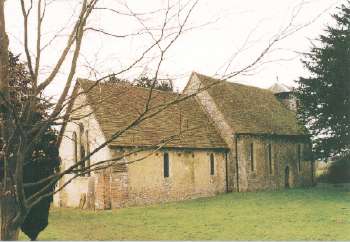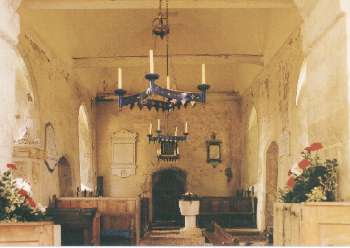![]()

![]()
20. St Michael Upmarden

This is one of the remoter West Sussex churches standing 500 feet up on the Downs between Compton and Stoughton, almost completely hidden by yew and elder trees. Access is only via a farm track in the tiny hamlet of Upmarden inhabited perhaps by some twenty people.
St Michael's dates from the 13th century. The church of flint and limestone with a weather boarded bell chamber is only a simple plastered double chamber with no aisles or transepts. With plain lancet windows throughout, white-washed walls and a bare red brick floor, at first glance it has a rather neglected appearance. This is nothing new, as a note in the church guide reveals that in 1625 it fell into a very sad state. It was reported that 'the chancel was indecently and beastly kept... through the pigeon dung and other filfth. People are not able to endure the ill and noysome smell thereof... but are enforced to stop their noses or carry flowers in their hands to prevent the smell thereof.' Fortunately repairs were soon made and the church survived.
Only three years ago traces of a medieval wall painting of St Christopher and the Christ child were discovered on the North Wall as well as three circular paintings in the chancel. The chancel itself, approached through an attractive double pointed arch is very plain, but its clear East window projects a fine sense of lightness. Two rather ramshackle box pews are found there where one would expect to find choir stalls. There is a square piscina in the South wall whilst an unusual trefoil headed second piscina can be seen in the nave under the easternmost window of the North wall.

The ancient tub font may date from the 12th century. There is no electricity in the church and lighting is by a series of iron chandeliers each holding four candles. The church appears to be unheated.
There are many seventeenth and eighteenth century tombstones on the floor of the church as well as a surprising number of memorials from that period. Two are of particular interest because of their imperial connections.
One, to Thomas Phipps who died on 22 May 1776, states that "he was spared by Providence of the Pain of knowing that he had survived his youngest son Richard Phipps who died in Dinagepore in the East Indies on 1 November 1775 in the 24th year of his age." An interesting example of the slowness of communications in the eighteenth century.
The second memorial on the North wall is to James Warner Thomas late midshipman of H.M. Ship Aetona. "This estimable and promising young man caught the yellow fever while in command of one of the boats of H.M.S. Aetona employed on a survey of the West coast of Africa and died at Porta Praya Cape de Verdz on 16 February 1834 aged 20." A somewhat unexpected memorial to find in a tiny inland village inhabited mostly by farm labourers.
As you leave by the South door note the crosses on the lintels possibly made by medieval pilgrims travelling between Winchester and Canterbury. And so into the wonderfully peaceful churchyard with its encircling yew trees and a chance to reflect on the timelessness of history and the sanctity of this small church certainly the most attractive of the three Marden churches.
written by John Symonds
![]() Return to the Summer 1998 Features page
Return to the Summer 1998 Features page
![]() return to Home page and main index
return to Home page and main index
page last updated 6 JULY 1998